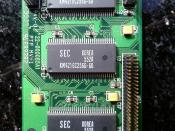Samsung ElectronicsSummarySamsung Electronics is the world's leader in DRAM and has been since 1992 when they overtook Hitachi. Samsung Electronics began in 1969 manufacturing black and white televisions. A small startup company called Korea Semiconductor Company began manufacturing wafers in 1974 but had weak financial backing and didn't have proprietary technology and began to struggle. Kun Hee Lee, the third son of Samsung's founder, decided to purchase Korea Semiconductor with his own personal savings, believing that the industry would experience huge growth and desiring to move into more advanced technology.
Lee ended up merging Korea Semiconductor and Samsung Electronics, attempting to create a global powerhouse for semiconductors and consumer electronics. In the 1980's, Kun Hee Lee convinced his father Byung Chull Lee that semiconductors was where the growth would be and that it would be financially advantageous for the company to move in that direction. Samsung Electronics became the golden child of the company and the Lees poured most of their resources into the electronics portion of the business.
Samsung needed outside expertise and technology so they forged an agreement with Micron to teach them how to produce 64K DRAMs. They were so convinced that their decision was a sound one that even when the semiconductor market went into a recession and Samsung Electronics was losing money in their memory chip segment, they continued to invest in it to gain market share.
Samsung's research and development was unique in that they actually had segments of this business development segment competing against each other. Teams in the U.S. and South Korea were asked to design 256K DRAM and to cooperate somewhat with each other but to see what they could come up with separately. In one instance the California team was successful and for the next generation...


